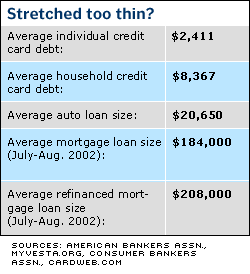NEW YORK (CNN/Money) -
Borrowing money makes life a lot easier. If your pockets are bare and there's something you need, you can usually find a loan to bridge the gap.
Indeed, it would be nearly impossible for most of us to pay for a house, a car or a college degree if we had to cough up the entire sum in cash. Simply put, debt provides opportunity.
But it also creates problems. The American Bankruptcy Institute reports that personal bankruptcy filings have jumped 44 percent since 1992, due largely to excessive levels of debt.
"In the last 20 years, consumer credit in our economy has expanded," said Keith Leggett, an economist at the American Bankers Association. "I view the expansion as generally positive. Consumption is a key driver of our economy. Opportunities are more egalitarian. But even good things can be dangerous, if they're misused."
And Americans do misuse debt, often spending more than they make. On average, Americans spend $1.22 for every dollar they earn, acccording to myvesta.org.
Take a look at the stats below, and see how you stack up.
The roof over your head
It's a good time for mortgages, and everyone knows it – they're rushing to the bank for new loans and refinancings. The 30-year fixed mortgage rate, at 6.01 percent as of the week ending Oct. 3, is near its all-time low since Freddie Mac began tracking it in 1971.
The average size of a mortgage for the purchase of a new home, from June to August of this year, was about $184,000. The average size of a refi during that period was about $208,000.
| Related stories
|

|
|
|
|
According to the National Association of Realtors, a median-priced home cost $162,800, as of July 2002. With a 20 percent down-payment, top-notch mortgage rates, and a median household income of $52,600, a person buying a median-priced home would pay about 18.9 percent of his monthly income in mortgage payments (of $827 each).
Most financial planners say a mortgage is debt worth carrying. Interest rates have recently flirted with 36-year historic lows, and you can deduct mortgage interest from your taxes, making it easier than ever to finance your own piece of the American Dream.
Still, you can get carried away even with "good debt". To get a sense of how much is too much (and how much is just right), click here. And if you want to learn about living debt-free, click here.
Going to school
Student loans are generally considered to be "good debt," too – a bachelor's degree or graduate degree can increase your earning power by as much as 80 percent over high school graduates, according to The College Board. What's more, you can deduct up to $2,500 in interest on student loans from your taxes come April 15.
To qualify for the full deduction, single grads must make under $50,000 (married folks must have a household income less than $130,000).

Still, going to school costs more each year. A fall 2001 report from the American Council on Education found that 60 percent of all bachelor's degree recipients from the class of 2000 graduated with college loan debt.
The median amount borrowed to finance a 4-year education at public schools was $15,375 – that's a $179 monthly payment – and the median amount borrowed for a 4-year private education was $17,250, or a $200 monthly payment.
For more on how to pay off student loans early, click here.
According to the State Public Interest Research Group's Higher Education Project, 39 percent of students graduate with unmanageable student loan debt – that is, monthly payments cost more than 8 percent of the graduate's income.
"Tuition costs have jumped, we've seen many state budget cuts on higher education in the past 2 years, and federal financial aid has failed to keep pace with these costs," said Ellynne Bannon, a spokesperson for the Higher Education Project. "In 1976, the maximum federal Pell Grant paid for 84 percent of a typical tuition at a 4-year public school. Today, the maximum award now pays for 39 percent of those costs."
Do you need wheels?
These days, the average auto loan is $20,650, according to the Consumer Bankers Association. But the value of investing in a car depends on your needs.
For most, a car is a necessity, required to get to work and back again and make trips to the grocery store. For others (say, a city dweller with access to public transportation), a car is a luxury.
Owning a car has many advantages (besides actually using the car): you'll have it to trade in for the next car you buy, and you can keep it for as long as it will run.
Just keep in mind that a car is a depreciating asset -- its value will drop the minute you drive it off the lot.
Plastic is not so fantastic
Finally, take a look at your high-interest debt.
Credit cards were originally designed for convenience: when you don't have cash on hand or don't want to carry excessive amounts of it, you can put it on your card, and pay it off at the end of the month.
But credit cards also encourage impulse buys. And shoppers with poor spending habits soon find themselves running on the minimum balance treadmill.
In 1990, the average household with more than one card carried $2,985 in credit card debt. Last year, that number hit $8,367, according to CardWeb.com. And according to Myvesta.org, the average individual credit card debt is $2,411, spread over 3 cards.
To limit damage from plastic, try to charge only what you can repay in full each month -- and set aside some cash to cover expenses in the event of an unforeseen emergency, like a layoff or a stay in the hospital.

|

